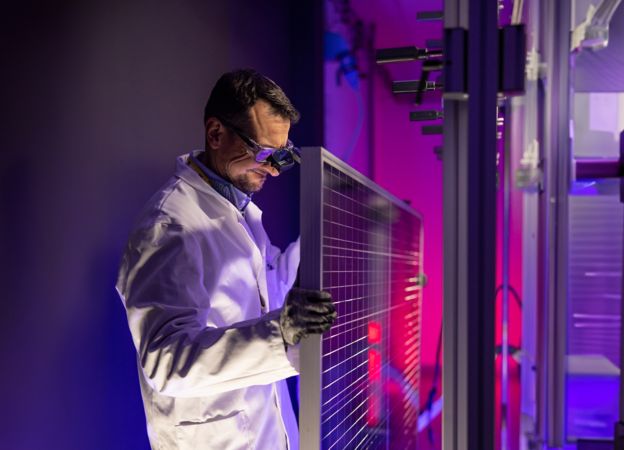
Renewable energy
New technologies to obtain sustainable energy from sun and wind.

Or , our new artificial intelligence tool.
Technology is the key to decarbonisation. That is why technology is at the heart of our strategy.
Chief Executive Officer of Eni

We develop technologies for the transition with the aim of accelerating business transformation and continuing on the path towards decarbonisation, thanks to the expertise of our Research Centres in Italy and a network of collaborations for global innovation.
We oversee every phase of technological innovation, from researching new solutions to developing pilot plants, and finally scaling up those technologies to industrial applications once they have passed all tests and proven to be the most efficient.
Developing new technological solutions is essential when it comes to reaching our Net Zero goals, which at the same time will allow us to maintain our technological leadership to be competitive and create value in the long term.

New technologies to obtain sustainable energy from sun and wind.

Proprietary technologies for quality biofuels that make mobility all the more sustainable.

Technologies and processes to derive new products and materials using plant-based raw materials and waste plastics.

Innovative technology and processes to capture and store CO₂ that can be partly reused in other industrial sectors such as the construction.
While we develop solutions to accelerate the energy transition, we continue to invest in exploration excellence, developing increasingly efficient and less invasive study and characterization technologies to develop increasingly complex assets.
The computing power of supercomputers, combined with the expertise of geologists and engineers, is the secret of our successes in geophysical exploration.
In our laboratories, we develop specific solutions for recovering soil and groundwater from industrial areas. Once successfully developed and tested, we apply them directly at our own production sites or at the sites of other companies where we operate through Eni Rewind.
According to the technological neutrality principle, there is no single solution to achieve the energy transition, we need a technological mix that can be adapted to different applications and needs. This is why we are developing a wide range of technologies that support the decarbonisation of each sector of the economy and our daily lives.
Eni's services and products cater to a variety of sectors and markets because each of them needs a specific approach to reducing emissions. Through the combination of advanced technologies, digitisation and contributions from Open Innovation, we support both industrial processes and end customers by taking care of the entire life cycle of a product: we do this from the procurement of raw materials, through the production stage to their final use.
This technology offers the real prospect of a safe energy transition based on a virtually unlimited resource.

Top international discoveries in research and technology. Discover the interactive special report.


If you want to change topic, clear the chat and make a new query to receive more relevant results.
This will delete the question history.
If you want to change topic, clear the chat and make a new query to receive more relevant results. This will delete the question history.
Here you can find the full list of your queries.
The answers are generated by artificial intelligence, therefore they may contain inaccuracies. Please read the terms and conditions of use.

EnergIA is an innovative tool based on artificial intelligence capabilities, which can help you navigate the contents of eni.com, quickly finding answers to your questions. EnergIA can also perform a search on a specific topic, providing the most up-to-date data available, or it can invite you to delve deeper into a topic of your interest by suggesting links and specific readings. Start now!
EnergIA is an innovative tool based on artificial intelligence capabilities, which can help you navigate the contents of eni.com, quickly finding answers to your questions. Start now!
EnergIA (ener'dʒia) is a system based on Generative Artificial Intelligence.
Thanks to this technology, we can respond to your requests by querying the most relevant content and documents available on eni.com. (Note: financial documents from the last 12 months and press releases from the last 2 years are considered.)
Through EnergIA, you can delve into topics of interest and have a real-time window into the world of Eni.
If you wish to search for a specific document, press release or news, use the traditional search engine via the magnifying glass icon.
Like all systems that leverage Generative Artificial Intelligence, EnergIA may generate inaccurate or outdated responses. Always consult the sources that EnergIA proposes as the origin of the generated information.
If the system fails to find an exact match for the requested content, it still tends to provide a response.
If you find any inaccuracies in the provided response, please send us your feedback at the bottom of the page: it will be very helpful for us to improve.
Remember that the content generated by the system does not represent Eni’s official position. We therefore invite stakeholders to refer to their designated contacts for official statements: Press Office for journalists, Investor Relations for analysts and investors, Company Secretariat for shareholders etc..
EnergIA can understand questions posed in almost all languages, but we prefer to provide you with a response in English or Italian, the two languages available on eni.com. If you ask a question in Italian, the content on the site in Italian will be consulted. If you ask it in English or any other language, the content in English will be consulted. (Note: the language Eni uses for financial documents/content is predominantly English.)
If questions are formulated that violate the set security criteria, the system will not proceed with processing the response. Please remember not to send personal data.
By using this service, the users acknowledge that they have read and accepted the terms and conditions of use.
Search
EnergIA (ener'dʒia) is a system based on Generative Artificial Intelligence.
Thanks to this technology, we can respond to your requests by querying the most relevant content and documents available on eni.com. (Note: financial documents from the last 12 months and press releases from the last 2 years are considered.)
Through EnergIA, you can delve into topics of interest and have a real-time window into the world of Eni.
If you wish to search for a specific document, press release or news, use the traditional search engine via the magnifying glass icon.
Like all systems that leverage Generative Artificial Intelligence, EnergIA may generate inaccurate or outdated responses. Always consult the sources that EnergIA proposes as the origin of the generated information.
If the system fails to find an exact match for the requested content, it still tends to provide a response.
If you find any inaccuracies in the provided response, please send us your feedback at the bottom of the page: it will be very helpful for us to improve.
Remember that the content generated by the system does not represent Eni’s official position. We therefore invite stakeholders to refer to their designated contacts for official statements: Press Office for journalists, Investor Relations for analysts and investors, Company Secretariat for shareholders etc..
EnergIA can understand questions posed in almost all languages, but we prefer to provide you with a response in English or Italian, the two languages available on eni.com. If you ask a question in Italian, the content on the site in Italian will be consulted. If you ask it in English or any other language, the content in English will be consulted. (Note: the language Eni uses for financial documents/content is predominantly English.)
If questions are formulated that violate the set security criteria, the system will not proceed with processing the response. Please remember not to send personal data.
By using this service, the users acknowledge that they have read and accepted the terms and conditions of use.
A new window into Eni’s world, at your disposal. EnergIA is an innovative tool based on artificial intelligence capabilities, which can help you navigate the contents of eni.com, quickly finding answers to your questions.


